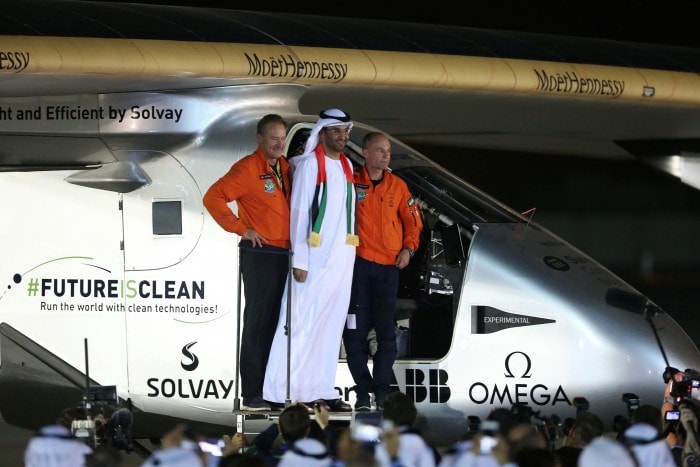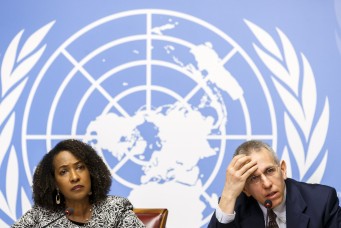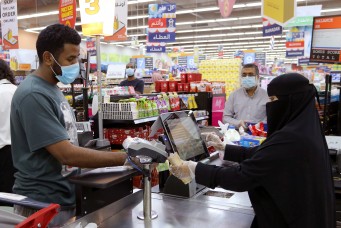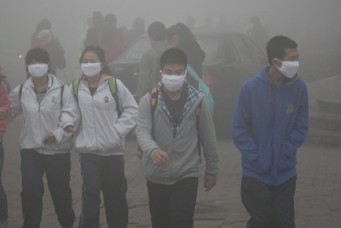Can Arab Cities Be Eco-Sustainable?
Separating fiction from reality, and corporate interests from true innovation in the new “eco-cities” of the Middle East.

Pilots pose with Sultan Ahmed al-Jaber, chief executive officer of the Abu Dhabi Future Energy Company (MASDAR), after the arrival of Solar Impulse 2, a solar powered plane, at an airport in Abu Dhabi, United Arab Emirates, July 26, 2016. Reuters/Jack Jabbour
Eco-cities and sustainable urban development are being heavily promoted worldwide and are gaining accelerated interest. There are dozens of new cities in China alone that claim to be sustainable or environmentally-friendly. Such new utopias are being planned in a number of other countries, and there are also rising numbers of enclave residential developments on urban fringes that boast eco-sustainable credentials. At the same time, even more interest and money are being directed toward making existing cities sustainable, smart, and ecologically correct. These concepts are coming to pervade urban planning and design disciplines, and they have stimulated the interest of a wide range of private companies and foundations—as well as governments—who see urban sustainability and the products that will be required as an extremely important part of any new tech future. They are also spawning specific standards and awards with which to measure and rank the march toward sustainability goals; a whole sub-industry of sustainable urban conferences and expositions is already well established.
However, the concepts driving these eco-city trends are extremely wide ranging, and it could be said that they are more than a bit fuzzy, with some labels of sustainability being applied to products and processes that are little more than new real estate products, property ventures, new consumer lifestyles, and other high-tech urban fixtures. The most common aspects of urban sustainability are pretty well-known and can be briefly summarized as evolving around three main principles: low-carbon, green, and smart/connected. These have come to imply a large number of specific actions and investments. Some of these are sensible and obvious, but some overlap, and are contradictory, or are frankly little more than cosmetic.
These are concepts and trends that have captured both public and investor interest in the West and have spread throughout the world. So how do Arab countries stack up? Here we take a quick look at ongoing eco- and smart-city initiatives found across the region and their even more ambitious proposals. Our aim is to separate fiction from reality and to consider the corporate as well as government motives operating behind the promotion of these twenty-first century artifacts.
To do this, it is important to divide Arab countries into two types. On the one hand, we have the rich Gulf Cooperation Council (GCC) countries, who have sovereign wealth funds and huge discretionary budgets, and whose sustainability challenges are intimately tied up with their hydrocarbon-based economies. We also have the rest of the Arab countries, all of whom have large and rapidly expanding cities with substantial portions of their populations who remain poor by any measure. These countries may have some petroleum and natural gas resources, but they remain lower middle-income countries whose development trajectories rest on promoting diverse and productive economies.
Eco-urban Experiments and Policies in Gulf Countries
Any consideration of eco-sustainability in the Arab countries of the Gulf must take into consideration four main facts. First, Gulf countries are huge consumers of energy. The world’s highest consumer is Qatar (at 17,922 kilograms of oil equivalent per capita, 2.5 times that of the USA), and Bahrain, Kuwait, Saudi Arabia, and the United Arab Emirates (UAE) all rank globally within the top ten. Second, Gulf countries are also massive greenhouse gas polluters. In 2014, the world average of carbon dioxide emissions per capita was 4.76 metric tons, whereas for Qatar the figure was 43.86 metric tons, with other Gulf countries not far behind. On the other hand, countries like Egypt were relatively very low polluters.
Third, Gulf countries have enormous foreign labor forces without which they could not function. In 2010, the UAE and Qatar led the pack with 88 and 86 percent, respectively, of their populations made up of foreign residents and with 96 and 94 percent of their workforces composed of immigrants. And Bahrain and Kuwait had over half of their populations and over two-thirds of their labor forces made up of foreigners. Only in Oman and Saudi Arabia did the number of foreigners represent less than half the population.
Fourth, Arab countries in the Gulf have for decades made diversifying their economies and reducing dependency on oil revenues important parts of their national strategies, but even after the near collapse of oil prices in 1998, and again in 2016, none have made measurable progress.
Faced with these rather discouraging facts, it is informative to look at how Gulf states are taking up the urban eco-sustainability banner. The UAE has probably done the most to promote sustainable urbanism, or at least invested the most both into experiments and rhetoric. In 2007, the government of Abu Dhabi launched Masdar City on a 6.35 square kilometer site next to the airport, based on a masterplan by Fosters + Partners. It was to be a new, “zero-carbon” high density town and “one of the world’s most sustainable cities,” relying wholly on solar energy, doing away with private cars (replacing them with Personal Rapid Transit, or PRT, pods), introducing micro-climate enhancements (including a vernacular wind tower), and erecting green buildings with smart energy management systems.
The Masdar experiment has garnered a huge amount of media interest. It now boasts a small number of modernist buildings, including those of the International Renewable Energy Agency and a handful of iconic global companies such as Siemens, Honeywell, and General Dynamics. But thirteen years after its establishment, Masdar remains very much a work in progress. Its modest target of a population of fifty-two thousand is far from being reached, and today there are less than 1,000 residents, most of whom are students at the Khalifa Institute of Science and Technology. Over 85 percent of the city’s surface area remains undeveloped. As a 2016 Guardian article puts it, “the world’s first planned sustainable city—the marquee project of the United Arab Emirates’ plan to diversify the economy from fossil fuels—could well be the world’s first green ghost town.” Instead, the Masdar initiative itself has metamorphized into a clean-tech lab and showroom, and its real calling, that of a platform for corporate experiments targeting the global market for eco-urban products, is now firmly in place.
The UAE has experimented with other urban sustainability initiatives, particularly in Dubai. These include a massive 200-megawatt (MW) solar power plant south of the city, which is being expanded to 1,000 MW; the only mass transit network in the Gulf states (four lines, driverless trains, and 46 stations, all air conditioned, mainly used by commuting foreign workers); and several other eco-features and regulations recently introduced by the municipality. The policies underlying these initiatives are mostly city-wide and generic, and thus have greater potential than Masdar to have some sustainability impact, but they will not at all reduce the UAE’s enormous dependence on hydrocarbons.
Dubai is also home to a recently completed upscale private residential compound called, unsubtly, “Dubai Sustainable City,” which covers about fifty hectares with 500 eco-connected villas and a ban on cars in most areas. Name aside, Dubai Sustainable City is simply a developer’s residential neighborhood project shoehorned into the edge of Dubai’s massive urban sprawl, but one that makes heavy use of eco features as its main selling point. It hardly qualifies as anything approaching carbon-footprint sustainable, since inhabitants are totally car-dependent to get anywhere and electricity consumption per household remains sky-high.
Like the UAE, Saudi Arabia has discovered that in order to diversify its economy away from fossil fuels, urban sustainability principles can help promote new urban ventures and new economic pursuits, and the roll call of the kingdom’s recently launched new cities is impressive. In 2005, King Abdullah Economic City (KAEC) was begun on a huge 137 square kilometer Red Sea site 100 kilometers north of Jeddah, aimed at a population of half a million people. Of its various elements—a major port, industrial complexes, leisure, resort, and residential zones—the most-high tech are university campuses flanked by two R&D parks and a “Smart City”. Unfortunately, KAEC remains a work in progress, and by 2020 (the year it was planned to be completed) only some 10 percent of the total land area has been developed, few industries or tech companies have settled in, and the population does not exceed ten thousand residents.
Undaunted, the kingdom has also announced at least four other new cities in the desert, the progress on which has been extremely slow. Even existing cities are getting a “sustainability wash” with a heavy emphasis on healthy lifestyles. A recent symposium entitled Sustainable Riyadh centered on four “well-being” projects to promote sustainable development, conservation, socioeconomic wellbeing, cultural nourishment, and the promotion of healthier lifestyles.
All of these plans have been completely eclipsed by the 2017 announcement by Crown Prince Mohamed Bin Salman of the “gigacity” NEOM, where interconnected, futuristic, and sustainable city concepts have been raised to dizzying heights. To be built on an enormous 4,000 square kilometer slice of desert on the Red Sea and Gulf of Aqaba (almost half the area of Lebanon) and estimated to cost $500 billion—not counting huge expected foreign investments—NEOM promises to be everything that is modern and cutting edge. Space-age artifacts abound, such as domestic robots, cloud seeding, flying taxis, hologram teachers, an artificial moon, a theme park with robotic dinosaurs, and glow-in-the-dark beaches. It is evidently aimed mainly at well-off jet-setters, and according to the plan, residents will be able to choose from more Michelin-starred restaurants per capita than in any other city on earth (what a metric).
However, progress on the ground has so far been very thin. NEOM Airport is nearly finished, the first phase of a workers’ village that can accommodate ten thousand laborers has been built, and the Saudi government is already hosting events at the site to generate investment and media attention (such as wind suit jumping and car rallies). A check using Google Earth images from 2018 and 2019 shows that practically nothing has been built, and the only new road is a coastline-hugging highway that is still under construction.
Qatar has been taking a more urban-grounded approach to sustainability. Since 2012, it has been developing “Downtown Doha,” which when finished will “produce one of the most eco-friendly city districts in the world”. It features solar panels, shaded streets, LEED-rated energy efficient buildings, and a separate greywater system. It includes the central interchange on Doha’s new metro network that will play an important role in ferrying fans for the World Cup in 2022. The main stadium for the Cup is being built in a totally new thirty-eight square kilometer waterfront development called Lusail City, which, according to its developer, will be “a smart and sustainable, modern city” that will absorb part of the projected growth of Qatar’s population and economy. As is often the case with many sustainable urban projects in the Gulf states, attempts are made to integrate the spirit and aesthetics of traditional architecture with sustainable design and modern technology. And in most cases, it is the contracted Western design firm that conceives these architectural integrations.
The other Gulf countries—Kuwait, Bahrain, and Oman—have been late to join their neighbors in promoting sustainable eco-cities, and what little they have accomplished is until now mostly cosmetic. In 2009, for example, the Bahrain World Trade Center was completed in Manama, a tapering dual tower structure whose main iconic feature is three massive wind turbines suspended between the two towers. The Bahrain Smart Cities Summit was held in 2019, and the government is currently in the process of banning plastic bags. Private developers in Oman are promoting a couple of residential enclaves outside Muscat (Medinat Al-Irfan and Blue City) that boast natural and eco features, and the Omani government has placed great hope in the new port and industrial city of Dukm in the south of the country. This project aims at opening up the sparsely settled region and also at diversifying the economy, but sustainability does not feature prominently as one of its promotional features. Kuwait aims to develop a 250 square kilometer satellite “Silk City” across the Jaber Causeway, which will include a center for environmental studies, and it is planned to be surrounded by a green belt of gardens. However, the main feature of the new town is a planned 234-floor mega skyscraper, hardly something that is eco-sensitive.
Eco-urban Experiments and Policies in Other Arab countries
While non-Gulf Arab countries have nothing like the resources of the Gulf states to pursue utopian urban dreams and promote sustainability of the built-environment, some of these countries have also begun down this path, at least in terms of rhetoric and declared long-term goals. Of these, Egypt has probably gone furthest, especially in the last few years. This has been based on the government’s long history of creating urban settlements in the desert, and since the late 1970s at least twenty-four new towns have been established while many more have been announced or are in the planning stages. The creation of these new towns has been part of the country’s spatial policy to deflect population growth away from the crowded cities of the Nile Valley and Delta and is the main underpinning of its Vision 2030. Unfortunately, the record shows that, while the new towns around Cairo have enjoyed huge public and private investments and are now the loci of mega-malls, private universities, hospitals, and corporate headquarters, their successes in attracting new inhabitants has been decidedly meager. According to Egypt’s official census, from 1986 to 2017, the eight new towns in the deserts around Cairo increased by only 0.9 million inhabitants, whereas over the same period the whole metropolis added a whopping 10.6 million persons.
Until recently, these new towns have not been promoted as being particularly eco-sustainable, and in fact—with their extensive sprawl, very low densities, unoccupied housing stock, heavy water use, total reliance on private transportation, huge energy consumption, and intended social exclusion—they represent the antithesis of anything approaching sustainability. But since 2014, over a dozen “fourth generation” new towns have been announced, of which New Al-Alamein, New Mansoura, and especially the New Administrative Capital are already under construction and are being heavily promoted as being eco-smart. As declared by President Abdel-Fattah El-Sisi, their aim is “to establish a new model for life in Egypt that depends on smart cities and keeping pace with the highest levels of global development in this field”. Private developers in these towns have leaped onto the eco-train to promote their projects, alongside the government which extolls digital, connected, and high-tech systems, and public buildings that are purported to be green and are being covered with solar panels. But the fact that, in terms of urban form and urban systems, these fourth generation’ cities repeat the excesses made in earlier new towns seems not to matter.
The hype surrounding these new smart cities seems to be ever-increasing. A special four-page spread on real estate in Egypt in the January 28, 2020 edition of the country’s leading daily was devoted to the need for and advantages of these Generation 4 cities, with the lead article implying that investment in them was the path to a superior “quality of life” for Egyptian citizens. And the same day the Egyptian Mail, reporting on an al-Azhar conference, managed to link religious discourse renewal with the nation’s sustainable development. It seems everything can be construed in terms of sustainability.
Morocco has also ventured into the world of eco-cities, although at a slower pace than Egypt. In 2004, the government began a program called “Villes sans bidonvilles” (cities without slums), which includes the creation of fifteen new towns by 2020 to reduce the pressure on existing cities, keep potentially anarchic urban development under control, and offer new living spaces to meet the needs of different social strata. Zenata, designated an “eco-site” in 2012 and located between Casablanca and Rabat, is one of these. A public-private venture, its designers say their systemic approach is unique in building a sustainable, environmentally friendly, and well-connected city. Aiming to have a total population of 300,000 with 100,000 jobs, Zenata is still in its initial phase with few inhabitants (but an Ikea mega store is already open). Other new towns in Morocco that have at least some eco/smart features are Ville Verte Benguérir (being built by the main Moroccan phosphate company) and Chrafate, a new town near Tangier and Morocco’s Automotive City.
A few other non-Gulf Arab countries have begun to prepare for an eco-urban future. In Jordan, a Bus Rapid Transit system is being built for Amman (much welcome in a city with horrible traffic and almost no public transport), and there is talk of creating a new, modern satellite city east of the capital. In Algeria, there have been discussions about the need for environmental urban planning, and a new “sustainable city” plan for Algiers has been elaborated. Similarly, the city of Oran has adopted a zero waste, energy efficiency and capacity building program. And in Tunisia, instead of creating new eco-cities, the government has been talking about a “programme national des villes durables en Tunisie” to be applied to existing urban agglomerations.
Eco-babble or the Real Deal?
Unfortunately, although certain elements and activities that claim an eco-sustainable pedigree are likely to become more and more prominent, overall these are developments, and the new towns or urban fringes in which they are located, continue the following five depressing trends:
First, the real estate sector, particularly that which promotes new suburban, high-end and gated-community developments, is a huge and growing industry throughout Arab countries and is already firmly entrenched in the urban landscape. It is mostly a mechanism for attaching eco-embellishments onto a project, something that could be called “greenwashing,” as a way for developers to market their products and to give them advantages over their competitors. For example, in Daily News Egypt’s recent “Real estate outlook 2020” special, projects were described as having such elements as cascading green terraces, floating pools, interactive roofs, spectacular green environments, smart homes with fully integrated services, solar energy lighting, walkable boulevards, jogging and biking lanes, vertical forests, privacy and round-the-clock security. But in the same breath, these projects are also described as emphasizing exclusive living, luxury apartments, private and pristine landscapes, universal brand introductions, scenic views of manicured lawns and extensive water features, avant-garde communities, smart parking, utmost comfort, privacy, and serenity, and ultra-smart and contemporary designs.
Such promotional campaigns can be found in almost all Arab countries, and point toward urban futures that will be ever more exclusive and segregated, no matter how greenwashed they appear.
Second, the private car is fixed to remain the defining feature of urban transport in both new and existing urban agglomerations. Mass public transport—especially metro systems—in spite of experiments in cities like Cairo, Dubai, and Amman, remain under-developed. Cairo’s third line is still only half finished, while ground-breaking for its fourth line has been delayed again and again. And instead of introducing cost-effective Bus Rapid Transit systems, the lure of high-tech monorails to connect Cairo with satellite new towns seems to have won the day, even though these are outrageously expensive and unproven even in the West. Sure, in some Arab cities the idea of adding in electric buses, promoting electric cars, or introducing smart, shared vehicle systems may sound like alternatives to the internal combustion engine, but these are cosmetic additions that are not going to erode the addiction to the private car that is needed to navigate over ever-increasing urban sprawl.
Third, the marketing of everything that can be construed as eco-urban is rapidly being transformed from niche to mainstream. We have already seen how Masdar, Abu Dhabi’s zero-carbon city, morphed into an eco-urban product development and marketing platform. This trend toward marketing and branding has been a common sight in Arab countries for years, but recently it seems that the idea has been, well, put on steroids. Take, for example, Abu Dhabi’s 2020 World Future Energy Summit, “the leading global industry event and exhibition for future energy, cleantech and sustainability,” with government and business leaders, 800 specialist exhibitors and 33,500 visitors from 170 countries. In a similar vein, there is the 2020 Intelligent Cities Exhibition and Conference, running for the fifth year in Cairo and touted as “the region’s leading smart and sustainable cities event,” which will be attended (coronavirus permitting) by “the most influential consultants, vendors, technology providers, systems integrators, CIOs, real estate investors, developers, mixed-use developers, industrial zone developers, contractors, city planners, architects, designers, and government and telecom authorities”.
This hyper-marketing of everything that could be considered even remotely smart, eco-urban, and clean-tech is probably an unavoidable consequence of both today’s intense mediatic attention on the effects of climate change and an enduring faith in technological miracles. But the real estate and eco-products being marketed are certainly not going to save the planet by themselves. Some of the products may improve connectivity and have a marginal eco-utility, but overall, these “best practices on building and managing the cities of tomorrow” are mostly just add-ons that reinforce existing low-density suburban sprawl and trends that favor car-oriented transport, exclusive neighborhoods, and high-energy urban futures.
Fourth, there is an inexorable appetite for even greater consumption of energy in cities, and Middle Eastern cities are no different. Much is made of reducing carbon footprints and shifting to renewables in Arab countries, but although there have been some recent laudable advances, projections of the already huge hydrocarbon consumption in both Gulf and non-Gulf cities continue to rise for the foreseeable future. Intermittent supply from growing solar and wind projects and the resulting lack in grid stability and integrity will continue to plague their greater use for years. In other words, covering roofs with solar panels is not going to be anything like transformative.
Fifth, digital, interconnected, and app-based smart cities are mainly a matter of personal convenience, automated systems, and controlled space that are not, perforce, transformative and eco-friendly. Sure, they allow for big data and expand the miracle of the internet, but is this the face of a new world of Arab cities or simply a way toward more convenient consumerism? As Life.ai CEO David Ladouceur put it for Forbes Magazine in November last year, “Many smart city projects have not met their goals. IoT [the Internet of Things] may make some efficiency gains, but it doesn’t automatically improve quality of life or reduce complexity… a true digital city requires technology that fades into the background and interactions that are seamless and focused on a positive human experience.”
To wrap up, some of what is happening to promote eco-sustainability in Arab cities is welcome, at least in (somewhat) introducing sustainability awareness and values, investing in more eco-friendly infrastructure, and integrating eco-friendly products into market economies. But anything transformative will be a long slog in the Gulf where weaning citizens off sky-high energy consumption (not to mention migrant labor) will not be easy. And in other Arab countries, there may be some practical eco-innovations that are being introduced, but these are small beer and tend to support decidedly unsustainable Western lifestyles and those which favor their tiny middle classes. In the end, with all the noise about urban sustainability in Arab countries, the word “cosmetic” comes very much to mind.
David Sims is an economist and urban planner with forty years of experience in Arab, African and Asian countries. He is the author of Understanding Cairo: The Logic of a City Out of Control.
Read MoreSubscribe to Our Newsletter





